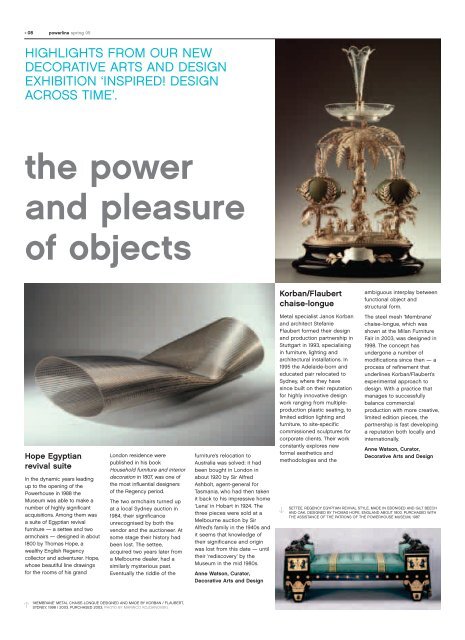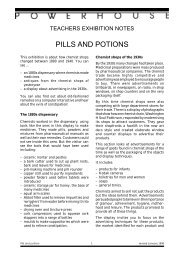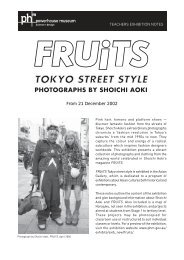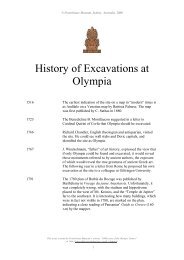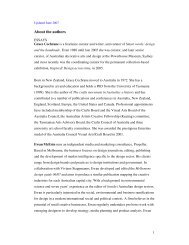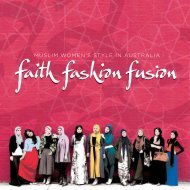design across time - Powerhouse Museum
design across time - Powerhouse Museum
design across time - Powerhouse Museum
You also want an ePaper? Increase the reach of your titles
YUMPU automatically turns print PDFs into web optimized ePapers that Google loves.
+ 08 powerline spring 05<br />
HIGHLIGHTS FROM OUR NEW<br />
DECORATIVE ARTS AND DESIGN<br />
EXHIBITION ‘INSPIRED! DESIGN<br />
ACROSS TIME’.<br />
the power<br />
and pleasure<br />
of objects<br />
Hope Egyptian<br />
revival suite<br />
In the dynamic years leading<br />
up to the opening of the<br />
<strong>Powerhouse</strong> in 1988 the<br />
<strong>Museum</strong> was able to make a<br />
number of highly significant<br />
acquisitions. Among them was<br />
a suite of Egyptian revival<br />
furniture — a settee and two<br />
armchairs — <strong>design</strong>ed in about<br />
1800 by Thomas Hope, a<br />
wealthy English Regency<br />
collector and adventurer. Hope,<br />
whose beautiful line drawings<br />
for the rooms of his grand<br />
London residence were<br />
published in his book<br />
Household furniture and interior<br />
decoration in 1807, was one of<br />
the most influential <strong>design</strong>ers<br />
of the Regency period.<br />
The two armchairs turned up<br />
at a local Sydney auction in<br />
1984, their significance<br />
unrecognised by both the<br />
vendor and the auctioneer. At<br />
some stage their history had<br />
been lost. The settee,<br />
acquired two years later from<br />
a Melbourne dealer, had a<br />
similarly mysterious past.<br />
Eventually the riddle of the<br />
‘MEMBRANE’ METAL CHAISE-LONGUE DESIGNED AND MADE BY KORBAN / FLAUBERT,<br />
SYDNEY, 1998 / 2003. PURCHASED 2003. PHOTO BY MARINCO KOJDANOVSKI.<br />
furniture’s relocation to<br />
Australia was solved: it had<br />
been bought in London in<br />
about 1920 by Sir Alfred<br />
Ashbolt, agent-general for<br />
Tasmania, who had then taken<br />
it back to his impressive home<br />
‘Lena’ in Hobart in 1924. The<br />
three pieces were sold at a<br />
Melbourne auction by Sir<br />
Alfred’s family in the 1940s and<br />
it seems that knowledge of<br />
their significance and origin<br />
was lost from this date — until<br />
their ‘rediscovery’ by the<br />
<strong>Museum</strong> in the mid 1980s.<br />
Anne Watson, Curator,<br />
Decorative Arts and Design<br />
Korban/Flaubert<br />
chaise-longue<br />
Metal specialist Janos Korban<br />
and architect Stefanie<br />
Flaubert formed their <strong>design</strong><br />
and production partnership in<br />
Stuttgart in 1993, specialising<br />
in furniture, lighting and<br />
architectural installations. In<br />
1995 the Adelaide-born and<br />
educated pair relocated to<br />
Sydney, where they have<br />
since built on their reputation<br />
for highly innovative <strong>design</strong><br />
work ranging from multipleproduction<br />
plastic seating, to<br />
limited edition lighting and<br />
furniture, to site-specific<br />
commissioned sculptures for<br />
corporate clients. Their work<br />
constantly explores new<br />
formal aesthetics and<br />
methodologies and the<br />
ambiguous interplay between<br />
functional object and<br />
structural form.<br />
The steel mesh ‘Membrane’<br />
chaise-longue, which was<br />
shown at the Milan Furniture<br />
Fair in 2003, was <strong>design</strong>ed in<br />
1998. The concept has<br />
undergone a number of<br />
modifications since then — a<br />
process of refinement that<br />
underlines Korban/Flaubert’s<br />
experimental approach to<br />
<strong>design</strong>. With a practice that<br />
manages to successfully<br />
balance commercial<br />
production with more creative,<br />
limited edition pieces, the<br />
partnership is fast developing<br />
a reputation both locally and<br />
internationally.<br />
Anne Watson, Curator,<br />
Decorative Arts and Design<br />
SETTEE, REGENCY EGYPTIAN REVIVAL STYLE, MADE IN EBONISED AND GILT BEECH<br />
AND OAK. DESIGNED BY THOMAS HOPE, ENGLAND ABOUT 1800. PURCHASED WITH<br />
THE ASSISTANCE OF THE PATRONS OF THE POWERHOUSE MUSEUM, 1987.


